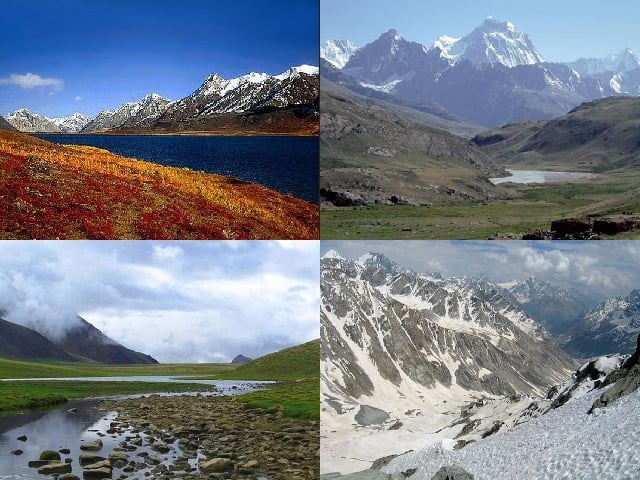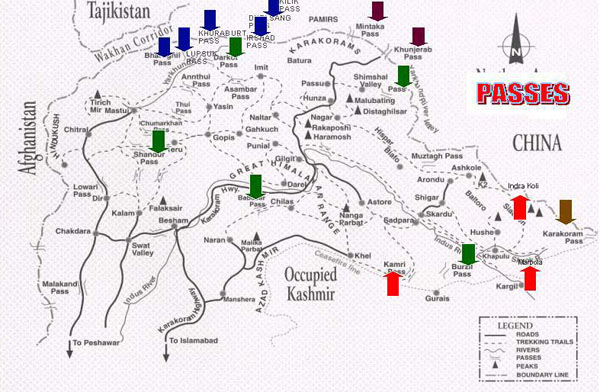Pakistan has a vital strategic location in South Asia and connects many South and Central Asian nations. Pakistan has built many roads and mountain passes covering its diverse landscapes to make this connection possible. These mountain passes in Pakistan, often considered engineering marvels, and are vital in maintaining essential trade routes.
Graana.com has compiled a list of Pakistan’s famous mountain passes, including their connections and elevations. The list is helpful for travellers and adventure seekers who want to explore the stunning landscape of Pakistan.
Passes of Pakistan
The mentioned below is the list of passes of Pakistan.
| 1 | Muztagh Pass | The Mustagh Pass, standing at 7,276 meters, is a vital trade route connecting Yarkand and Skardu. It has been historically used by caravans heading towards Srinagar in Kashmir. |
| 2 | Gondogoro Pass | The Gondogoro Pass links Concordia to the Hushe Valley, standing at 5,585 meters. |
| 3 | Lupghar Pir | It is a village located in West . The location is positioned at a height of 5,190 meters (17,030 feet) above the sea level. |
| 4 | Hispar Pass | Hispar Pass is a mountain pass in Pakistan, at 5,128 meters altitude in the Karakoram Range. |
| 5 | Irshad Pass | Located in the Karakoram Range, Hispar Pass stands at a height of 5,128 meters in Pakistan. |
| 6 | Chaprot Pass | Chaprot Pass, located in Nagar District, is a mountain pass with an elevation of 4,900 meters. |
| 7 | Kilik Pass | The Karakoram Mountains’ Kilik Pass, at an elevation of 4,827 meters (15,837 feet). |
| 8 | Didrillithe Pass | Didrilli Pass connects Ghizar district of Gilgit to Swat Valley at an altitude of 4,800 meters. |
| 9 | Mintaka Pass | The Mintaka Pass is a route that links Pakistan and Xinjiang, China. It sits at an altitude of 4,709 meters. |
| 10 | Hayal Pass | Hayal Pass is located in Naltar Valley, Pakistan. It stands at an elevation of 4,700 meters (15,420 feet). |
| 11 | Khunjerab Pass | The Khunjerab Pass connects Pakistan and China and sits at 4,693 meters or 15,397 feet. |
| 12 | Naltar Pass | Naltar Pass, at 4,600 meters, connects Kaghan Valley to Chilas via Thak Nala on the Karakorum Highway. |
Main Passes
| 13 | Dorah Pass | Dorah Pass links Afghanistan’s Badakshan Province to Khyber Pakhtunkhwa in Pakistan, at a height of 4,300 meters above sea level. |
| 14 | Bashkaro Pass | The Bashkaro Pass, which is 4,294 meters (16,155 feet) tall, connects Swat Valley and Ghizer Valley in Gilgit-Baltistan, Pakistan. |
| 15 | Babusar Pass | The Babusar Pass connects Khyber Pakhtunkhwa and Gilgit-Baltistan. It has an elevation of 4,173 meters (13,691 feet). |
| 16 | Burzil Pass | The Burzil Pass links Gilgit to Skardu and Srinagar via the Deosai Plateau, standing at 4,100 meters (13,500 feet) above sea level. |
| 17 | Broghil Pass | The Broghil Pass connects Afghanistan and Pakistan at 3,798 meters high. |
| 18 | Shandur Top | Shandur Top, located at an altitude of 3,738 meters (12,500 feet), connects Gupis in Gilgit with Chitral. |
| 19 | Badawi Pass | The Badawi Pass links Upper Dir District to Utror & Kalam in Khyber Pakhtunkhwa, Pakistan, at 3,523 meters (11,558 feet). |
| 20 | Lowari Pass | The Lowari Pass road is a high-altitude route connecting Chitral and Dir in Khyber-Pakhtunkhwa, Pakistan, with an elevation of 3,118 meters (10,230 feet). |
| 21 | Peiwar Pass | Peiwar Pass links Afghanistan’s Paktia Province with Pakistan’s Kurram Agency at an altitude of 2,615 metres (8,579 feet). |
| 22 | Khojak Pass | Khojak Pass in Pakistan connects Qila Abdullah and Chaman and sits at 2,290 meters (7,513 feet). |
Other Passes
| 23 | Bolan Pass | The Bolan Pass links Quetta and Sibi by road and railway at 1,793 meters (5,884 feet). |
| 24 | Malakand Pass | The pass named Malakand connects Peshawar and Chitral and sits at an altitude of 1,362 meters (4,469 feet). |
| 25 | Karakar Pass | Karakar Pass connects Swat and Buner in Khyber Pakhtunkhwa, Pakistan. It is 1,336 meters (4,384 feet). |
| 26 | Gumal Pass | Gumal Pass connects Afghanistan and Pakistan at an altitude of 1,098 meters (3,602 feet). |
| 27 | Khyber Pass | The Khyber Pass, at an elevation of The road called Khyber Pass links Spin Ghar to Peshawar. It sits on 1,070 meters (3,510 feet). |
| 28 | Kohat Pass | Kohat and Peshawar are connected by the Kohat Pass, which has an elevation of 855 meters (2,805 feet). |
| 29 | Zargar Pass | The route connecting Gilgit to China is called the Zargar Pass. It is 427 meters (1,401 feet) high. |
| 30 | Tochi Pass | Tochi Pass, which sits at an elevation of 324 meters (1,063 feet), is a crucial link between Bannu, Pakistan and Ghazni, Afghanistan. |
Main Passes Of Pakistan

Below is a list of the central mountain passes located in Pakistan.
Khyber Pass
At an elevation of 1,070 metres, the Khyber Pass is one of Pakistan’s oldest and most renowned mountain passes. It links the town of Landi Kotal near the Afghan border to Peshawar, spanning 53 kilometres. Historically, it played a crucial role in facilitating trade along the Silk Route, enabling the exchange of valuable goods like gold, silver, silk, and spices.
Bolan Pass
Located at 1,793 metres, Bolan Pass stretches for 89 kilometres through the Toba Kakar range in Balochistan. It served as a vital trade route, much like its northern counterpart, Khyber Pass, allowing traders and nomadic tribes to access South Asia.
Lowari Pass
Lowari Pass, also known as Lowari Top, stands at an elevation of 3,118 meters, making it one of the lower mountain passes in Chitral. It connects Chitral with Dir in Khyber Pakhtunkhwa and features two tunnels, known as Lowari Tunnels, enhancing year-round connectivity.
Broghil Pass
Reaching an elevation of 3,798 metres, Broghil Pass is among Pakistan’s highest mountain passes. It links Chitral in Khyber Pakhtunkhwa, Pakistan, with the Wakhan district in Badakhshan, Afghanistan. The pass is closed for around three months every year because of the heavy snowfall.
Malakand Pass
Malakand Pass, situated at 1,362 metres in Khyber Pakhtunkhwa’s Malakand District, boasts a well-paved road but can get congested with large vehicles during peak hours. It starts in Dargai and extends to the plains of Mardan, offering scenic views of the Swat Canal and the historic Malakand Fort.
Shandur Pass
Shandur Pass, often called the ‘Rooftop of the World,’ is a flat plateau located at 3,700 metres above sea level. It connects the Ghizer district of Gilgit Baltistan with the Chitral district of Khyber Pakhtunkhwa and is known for hosting the Shandur Polo Festival.
Khunjerab Pass
The highest mountain pass in Pakistan, Khunjerab Pass, reaches an elevation of 4,693 metres. Situated at the China-Pakistan border, it plays a vital role in the China-Pakistan Economic Corridor and is the highest point on the famous Karakoram Highway. It connects Hunza Nagar in Gilgit Baltistan with Xinjiang, China.
Dorah Pass
Dorah Pass, standing at 4,300 metres, links the Badakshan province in Afghanistan to Chitral District in Khyber Pakhtunkhwa, Pakistan. The Durand Line, the international border between Afghanistan and Pakistan, runs through the Hindukush mountain range.
Khojak Pass
At an elevation of 2,290 metres, Khojak Pass is one of Pakistan’s lower mountain passes, connecting Qillah Abdullah with Chaman in Balochistan. The Khyber Pass is near the Middle East and the Indian subcontinent.
Passes Of Pakistan On Map

Conclusion
The mountain passes found in Pakistan are remarkable examples of engineering and hold significant historical, cultural, and strategic importance in the region’s trade and connectivity. These passes, whether high in the Karakoram or lower in the southern ranges, are more than just routes; they tell stories of human perseverance and relationships. They show the lasting spirit of a region that has experienced many travellers, merchants, and explorers passing through over the centuries.
Pakistan’s mountain passes are more than geographical features; they are gateways to understanding the complex tapestry of a nation’s past and present. They are invitations to explore breathtaking landscapes, discover diverse cultures, and forge connections that transcend borders. In every twist and turn, in every elevation gained, these passes beckon us to embark on our journey of exploration and discovery.
(FAQs)
Some of the frequently asked questions related to these amazing passes in Pakistan are listed below.
What is the highest mountain pass in Pakistan?
The Khunjerab Pass is the highest mountain pass in Pakistan, reaching an altitude of 4,693 metres (15,397 feet).). It connects Pakistan with China and plays a crucial role in the China-Pakistan Economic Corridor.
What is the historical significance of the Khyber Pass?
The Khyber Pass is one of Pakistan’s oldest and most historically significant mountain passes. It has been a vital trade route for centuries, facilitating the exchange of goods along the Silk Route.
Are there any year-round open passes in Pakistan?
Yes, some passes in Pakistan remain open year-round, thanks to modern engineering. The Lowari Pass, for example, connects Chitral with Dir in Khyber Pakhtunkhwa and features tunnels that ensure year-round connectivity.
Which pass connects Pakistan with Afghanistan?
The Peiwar Pass connects Pakistan’s Kurram Agency with Afghanistan’s Paktia Province. It has historical and cultural significance due to its role as a crossroads of cultures.
What is the importance of the Bolan Pass in Pakistan’s history?
The Bolan Pass, located at an elevation of 1,793 metres, has historical significance as a trade route similar to the Khyber Pass. It allowed traders and nomadic tribes access to South Asia.
Can tourists visit these mountain passes in Pakistan?
Yes, many of these mountain passes are accessible to tourists and adventurers. However, checking local conditions and safety measures is essential, especially for higher-altitude passes like Khunjerab Pass.
How do these mountain passes contribute to Pakistan’s trade?
These mountain passes facilitate trade between Pakistan and neighbouring countries like China and Afghanistan. They are crucial for the movement of goods and people.
Are there any annual events or festivals associated with these passes?
Yes, the Shandur Pass is famous for hosting the Shandur Polo Festival, a thrilling event that attracts visitors from around the world. It’s a unique cultural experience amidst the breathtaking landscapes.
Are there any challenges or risks associated with crossing these passes?
Many mountain passes are vulnerable to harsh weather, such as heavy snowfall, due to their high altitudes. Travellers should be prepared for challenging terrain and varying weather.
Do these passes have historical and cultural significance for the local communities?
These passes are often deeply ingrained in the history and culture of the regions they connect. They have been used for centuries for trade, migration, and cultural exchange.
If you want to know about mountains ranges in Pakistan, Follow Graana.com.




